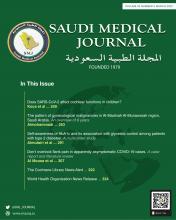Original Articles
Does SARS-CoV-2 affect cochlear functions in children?
Contralateral supression amplitudes.
Koca et al determine the influence of coronavirus disease-19 (COVID-19) on cochlear tasks of children who had COVID-19 previously, and the relevance among disease seriousness and cochlear involvement by otoacoustic emissions. Transient evoked otoacoustic emission (TEOAE), distortion product otoacoustic emission, and contrlateral suppression of otoacoustic emission measurements are carried out for each child. The comparison of TEOAE test results under masking shows a considerable difference between 3 groups. Distortion product otoacoustic emission test results of hospitalized outpatient and control group shows a statistically significant difference at 2 kHz among themselves. They concluded that their results suggest that severe acute respiratory syndrome coronavirus-2 may influence the medial olivocochlear system of children and have irreversible effects on the cochlear functions. Early detection of problems that may affect cochlear functions is a special critical task, especially in children.
see page 259
The pattern of gynecological malignancies in Al-Madinah Al-Munawarah region, Saudi Arabia. An overview of 6 years
The prevalence of a specific type of pathological diagnosis from 2015-2021.
Almohammadi describes the frequency and spectrum of different types of gynecological malignancies and characterizes the pattern of gynecological neoplasms in different age groups in Al-Madinah Al-Munawarah, Saudi Arabia. Endometrial cancer is the most common malignancy for women of 31 years and above. Tumors of the uterine corpus are mostly epithelial and possessed an endometrioid carcinoma histology. There is only a small decline in gynecological cancer incidences in Al-Madinah Al-Munawarah over the past 6 years. The author concluded that most of the cancer incidences, regardless of the pathological diagnosis, either increase or remain unchanged over time, is a possible indication of the current state of health programs and information available to the citizens in Al-Madinah Al-Munawarah. Further studies exploring the economic background of diagnosed patients may be of interest to future research.
see page 283
Self-awareness of HbA1c and its association with glycemic control among patients with type 2 diabetes. A multicenter study
Almutairi et al measures the self-awareness of hemoglobin A1c (HbA1c) prevalence among type 2 diabetic Saudi patients and its association with glycemic control, thereby identifying those factors that might affect their glycemic control. The subject’s self-awareness on the HbA1c test is assessed based on the combined score of 4 questions. The prevalence of HbA1c self-awareness is approximately 44.5%. They concluded that There is a positive association between HbA1c self-awareness and glycemic control. Glycemic control is good among those who are educated on the meaning of the test, their levels, and their target goal. Awareness among health care providers regarding the role of the patient’s education regarding their condition might help in providing the patient with optimal care.
see page 291
Case Report
Don’t overlook flank pain in apparently asymptomatic COVID-19 cases. A case report and literature review
Baseline axial computed tomography image through the lower chest showing: a) patchy ground glass and reticular opacities in the peripheral lung bases.
Al Mousa et al present a young male patient with mild/asymptomatic coronavirus disease-2019 (COVID-19) infection presented with flank pain secondary to the renal infarction, which was detected on the computed tomography (CT) of the abdomen. Coronavirus disease-2019 infection is a hypercoagulable state associated with serious thrombotic complications. However, these thrombotic complications are also being reported as a presenting symptom in asymptomatic and mildly symptomatic cases of COVID-19 infection in the absence of any other predisposing risk factors. Renal infarction is one of these thrombotic complications and can present with ambiguous abdominal symptoms leading to irreversible organ damage and other thromboembolic complications, if not diagnosed in time. They concluded that physicians must be aware of such uncommon presenting complaints of COVID-19 infection and include it in the differential diagnosis of patients presenting with abdominal symptoms.
see page 307
- Copyright: © Saudi Medical Journal
This is an Open Access journal and articles published are distributed under the terms of the Creative Commons Attribution-NonCommercial License (CC BY-NC). Readers may copy, distribute, and display the work for non-commercial purposes with the proper citation of the original work.









